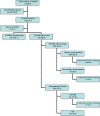Pre-hospital advanced airway management by experienced anaesthesiologists: a prospective descriptive study
- PMID: 23883447
- PMCID: PMC3733626
- DOI: 10.1186/1757-7241-21-58
Pre-hospital advanced airway management by experienced anaesthesiologists: a prospective descriptive study
Abstract
Introduction: We report data from the first Utstein-style study of physician-provided pre-hospital advanced airway management.
Materials and methods: Anaesthesiologists from eight pre-hospital critical care teams in the Central Denmark Region (a mixed rural and urban region with 1.27 million inhabitants) prospectively registered data according to the template for reporting data from pre-hospital advanced airway management. Data collection took place from February 1st 2011 to October 31st 2012. Included were patients of all ages on whom pre-hospital advanced airway management was performed. The objective was to estimate the incidences of failed and difficult pre-hospital endotracheal intubation, and complications related to pre-hospital advanced airway management.
Results: The overall incidence of successful pre-hospital endotracheal intubation among 636 intubation attempts was 99.7%, even though 22.4% of pre-hospital endotracheal intubations required more than one intubation attempt. The overall incidence of complications related to pre-hospital advanced airway management was 7.9%. Following rapid sequence intubation, the incidence of first pass success was 85.8%, the overall incidence of complications was 22.0%, the incidence of hypotension 7.3% and that of hypoxia 5.3%. Multiple endotracheal intubation attempts were associated with an increased overall incidence of complications. No airway management related deaths occurred.
Discussion: The overall incidence of successful pre-hospital endotracheal intubations compares to those found in other physician-staffed pre-hospital systems. The incidence of pre-hospital endotracheal intubations requiring more than one attempt is higher than suspected. The incidence of hypotension or hypoxia after pre-hospital rapid sequence intubation compares to those found in UK emergency departments.
Conclusion: Pre-hospital advanced airway management including pre-hospital endotracheal intubation performed by experienced anaesthesiologists is associated with high success rates and relatively low incidences of complications. An increased first pass success rate following pre-hospital endotracheal intubation may further reduce the incidence of complications and enhance patient safety in our system.
Figures
References
-
- Lossius HM, Soreide E, Hotvedt R, Hapnes SA, Eielsen OV, Forde OH, Steen PA. Prehospital advanced life support provided by specially trained physicians: is there a benefit in terms of life years gained? Acta Anaesthesiol Scand. 2002;46(7):771–778. doi: 10.1034/j.1399-6576.2002.460703.x. - DOI - PubMed
-
- Davis DP, Dunford JV, Poste JC, Ochs M, Holbrook T, Fortlage D, Size MJ, Kennedy F, Hoyt DB. The impact of hypoxia and hyperventilation on outcome after paramedic rapid sequence intubation of severely head-injured patients. J Trauma. 2004;57(1):1–8. doi: 10.1097/01.TA.0000135503.71684.C8. discussion 8-10. - DOI - PubMed
-
- Adnet F, Jouriles NJ, Le Toumelin P, Hennequin B, Taillandier C, Rayeh F, Couvreur J, Nougiere B, Nadiras P, Ladka A. et al.Survey of out-of-hospital emergency intubations in the French prehospital medical system: a multicenter study. Ann Emerg Med. 1998;32(4):454–460. doi: 10.1016/S0196-0644(98)70175-1. - DOI - PubMed
Publication types
MeSH terms
LinkOut - more resources
Full Text Sources
Other Literature Sources
Medical


